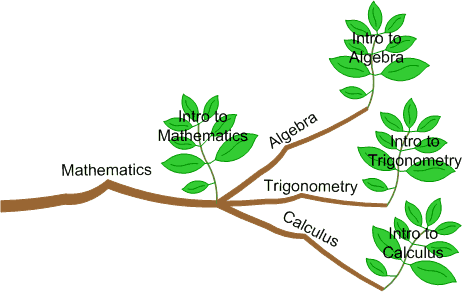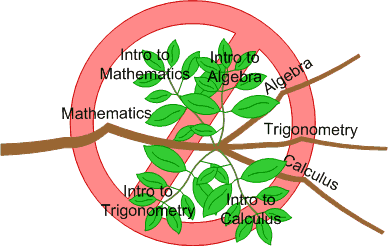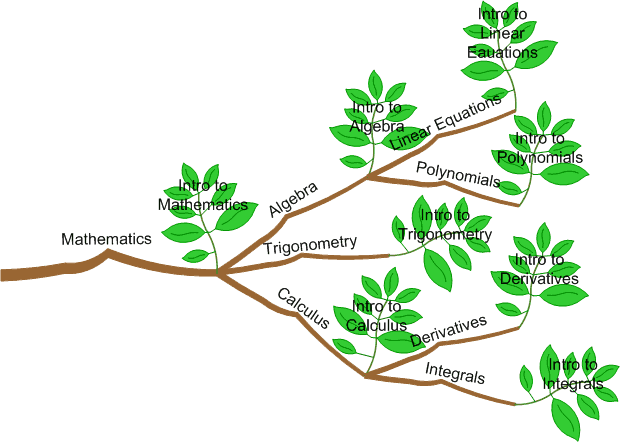DEMCS™ Branches, Stems, & Leaves Metaphor
One Topic per Subject
When looking at the diagrams, notice that there is only one stem at any juncture or end of a branch. This illustrates another unique aspect of the way DEMCS™ organizes subjects. Each subject really only contains one topic at that level. This topic serves a dual role:
- It is essentially the overview for that subject.
- It serves as the introduction for any existing or potential sub-subjects.
To make this easier to illustrate, lets give some names to the branches we have so far.

See how the Math branch has one stem at its end which consists of a topic that is a description of mathematics in general. Three branches have grown out of the end, representing Algebra, Trigonometry, and Calculus. Each of those has their own stem which is an introduction to that particular subject. (Please note that the subject names listed here are not necessarily the same ones that will be used in the actual system. They are for illustrative purposes only. I am trying to use a basic subject breakdown that most people will be familiar with.)
Now, we all know that a few paragraphs of introduction to Algebra or Calculus will not get us through college. (My apologies to Trigonometry teachers everywhere but there is only so much room in my diagram for more branches.) So each of those branches grows some additional branches. And each of those has a stem with leaves at the end which represents an overview of those subjects.
One may wonder how a bunch of overviews can really contain all the information a student needs to learn about a given subject. Just remember, each of those overviews gets more and more specific as you work your way further out on the limb. So, in this metaphor, you really do have to go out on a limb in order to learn anything. It's kind of like real life. And it's really not much different from a good textbook either. There is an introduction for each major part, then one for each chapter, then one for each section in the chapter. Finally, each paragraph has an introductory sentence. The only difference is that any subject in DEMCS™, no matter how specific, can always be broken up into more parts that are even more specific. Any branch can always grow another branch at the end.
It is important to notice that additional topics are not added simply by growing additional stems directly on the end of a branch. Suppose we did this. Take a look at the following diagram:

Now suppose that we needed to grow more branches for the child-subjects of Algebra. Where would we put them? At the end of the stem? No. Even though the stem is actually just a regular folder, this would then mix all the files for the topic in with the folders for child-subjects. Then it is no longer as easy for a user or software to copy only the files they need. (There is another, much more important, reason that has to do with the naming system for the folders which will be discussed later.) How about just adding the child-subject at the end of the branch as before? Well, this does allow us to grow more branches as needed. However, when a user wants to copy an entire subject with all of its child-subjects they can no longer simply copy one entire folder and be done with it. They have to copy that folder and remember to get the one folder that contains the introduction to that subject. Otherwise it would be like ripping out the introduction to a book before loaning it to a friend. By putting the introduction as a stem on the branch for the subject rather than on the branch for its parent subject it is easier to just snip off one branch and take everything associated with it still attached. Just like it is easier to zip up one folder than a folder plus one if its siblings.
What this means is that we have to create two folders when we want to add a sub-topic. One for the branch, and one for the stem. As you can see from the diagrams, this does not add a proliferation of useless folders. New sub-subjects are created in the "branch folder" and the files for the topic are placed in the "stem folder" so nothing of the tree is wasted, so to speak.
Next: Languages...



